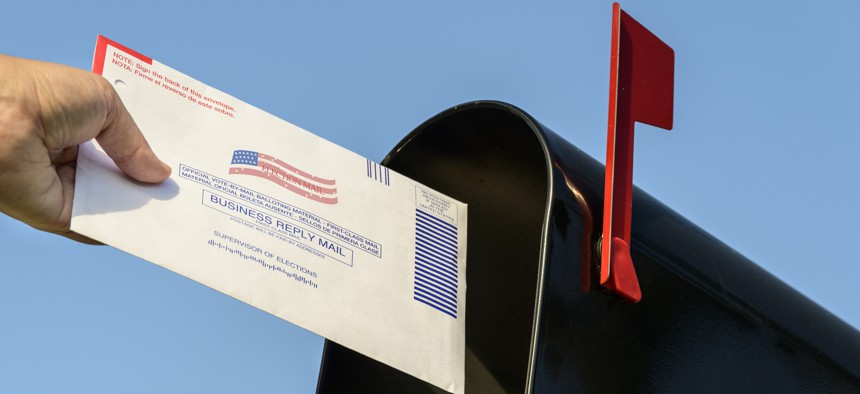USPS issues could undermine mail-in ballots, letter warns

Tetra Images via Getty Images
The bipartisan letter raised several “ongoing concerns” that it warned could disenfranchise voters. In response, embattled Postmaster General Louis DeJoy rejected many of the issues listed.
A bipartisan group of state and local elections officials are sounding the alarm about whether the U.S. Postal Service can handle the expected influx of absentee ballots in the coming weeks.
Leaders of the National Association of State Election Directors, the National Association of Secretaries of State and 29 local election official associations raised several “ongoing concerns” in a letter to U.S. Postmaster General Louis DeJoy last week. In it, the election officials wrote that Postal Service staff have received “inconsistent” training on handling election mail, delivery times have been “exceptionally long” and an increasing amount of mail has been returned as undeliverable.
The letter comes as state and local officials are bracing themselves for another hectic election season. And while it may not be as chaotic as 2020, when the COVID-19 pandemic led to a massive increase in voting by mail, the group highlighted what they termed as “persistent issues” that continue to dog election mail, even outside of peak campaigning periods.
“Important election mailings are sent year-round, however, and lasting improvements to election mail processing require continuous attention and emphasis,” officials wrote, adding that they have “not seen improvement or concerted efforts to remediate our concerns.”
On the issue of training, the letter said Postal Service employees from top to bottom are “uninformed” about the agency’s election mail policies. That lack of training, it warned, could mean ballots are held, delayed or improperly processed, and the risk of misdelivery could lead to voters being disenfranchised. While the associations recognize the difficulty of training 600,000 staff properly and consistently, election officials said more must be done.
“The frequency and widespread distribution of training-related issues, however, make it clear that these are not one-off mistakes or a problem with specific facilities,” they wrote. “Instead, it demonstrates a pervasive lack of understanding and enforcement of USPS policies among its employees.”
Election officials also remain concerned about “exceptionally long” delivery times, which the letter said often exceed the service’s three to five business day delivery standard for First Class mail.
The letter alleges that in nearly every state, election officials still receive ballots postmarked on time well after Election Day, even as many voters continue to follow instructions to return mail-in ballots as soon as possible. “There is no amount of proactive communication elections officials can do to account for USPS’ inability to meet their own service delivery timelines,” the letter said.
State and local officials also said mail is being marked as undeliverable “at higher than usual rates.” The groups warned that if mail is undelivered, it risks making that individual an inactive voter on the voter rolls under the National Voter Registration Act.
In response to the letter, DeJoy wrote this week that he rejects the concerns raised by the secretaries of state and elections directors, arguing the Postal Service has already “discussed and addressed” them.
DeJoy said the agency routinely briefs state and local officials on its modernization and reform efforts, a 10-year plan known as Delivering for America that includes using centralized centers to sort mail rather than individual post offices and using 60 mega-centers for the service’s processing operations.
That 10-year plan has already come under fire in Congress, while the Postal Service’s own regulator, the Postal Regulatory Commission, has argued for all reform efforts to be paused because of problems the rollout has encountered. DeJoy has been under sustained scrutiny for his handling of the 2020 election, and for his proposed reforms.
“Let us reiterate, modernization and enhancement plans will not have an impact on Election Mail, and we have committed to limit network changes to avoid any unintended disruption in service for the upcoming election and peak season,” DeJoy wrote in the letter provided to Route Fifty. “Furthermore, as demonstrated consistently in previous elections, Election Mail routinely outperforms our regular service performance due to our long-standing processes and procedures.”
The Postal Service said in August that it is committed to “secure and timely” delivery of election mail this year, including implementing its “proven” extraordinary measures from Oct. 21 to Nov. 15 to make sure ballots are delivered in a timely fashion. Those measures could include extra pickups and deliveries, as well as special plans to speed up sorting and processing. In 2020, the service delivered 99.89% of ballots from voters to elections officials within seven days, and 99.93% within the same timeframe in 2022 using extraordinary measures.
But the Postal Service’s overall performance is sliding, and has been the subject of criticism from many quarters, including former President Donald Trump. Earlier this year, the service’s Office of Inspector General found that while the agency had successfully implemented most of its initiatives, service performance scores went down at the same time. The inspector’s dashboard shows on-time service percentage nationally is at 85.6%, down from its target of 93%, meaning mail is not arriving as quickly as it should be. In only two states—California and Hawaii—is the agency exceeding its goal, per the inspector’s quarterly updated dashboard.
The letter from election officials said state and local officials need the Postal Service to be a “committed partner.” Not acting on their concerns, they said, would “risk limiting voter participation and trust in the election process.”






